Evaluating Growth and Photosynthesis of Kimchi Cabbage According to Extreme Weather Conditions
Abstract
:1. Introduction
2. Materials and Methods
2.1. Plant Materials
2.2. Growth Environment Factors and Extreme Weather Treatments
2.3. Growth Parameter Analysis
2.4. Measurement of Photosynthetic Rate for Developing Photosynthetic Rate Models
2.5. Development and Validation of Photosynthetic Rate Models
2.6. Experiment Design and Statistical Analysis
3. Results
3.1. Growth Parameter Analysis
3.2. Assessment of Growth Curves and Relative Growth Rate
3.3. Comparative Assessment of the Developed Photosynthetic Rate Model
4. Discussion
4.1. Growth of Kimchi Cabbage during Extreme Weather Events
4.2. Prediction of Photosynthetic Rate of Kimchi Cabbage
5. Conclusions
Author Contributions
Funding
Acknowledgments
Conflicts of Interest
References
- Openart, R.T.; Lo, S. Genetics of heat tolerance in heading Chinese cabbage. HortScience 1979, 14, 33–34. [Google Scholar]
- Choi, E.Y.; Seo, T.C.; Lee, S.G.; Cho, I.H.; Stangoulis, J. Growth and physiological responses of Chinese cabbage and radish to long-term exposure to elevated carbon dioxide and temperature. Hortic. Environ. Biotechnol. 2011, 52, 376–386. [Google Scholar] [CrossRef]
- Son, I.C.; Moon, K.H.; Song, E.Y.; Oh, S.; Seo, H.; Moon, Y.E.; Yang, J. Effect of differentiated temperature based on growing season temperature on growth and physiological response in Chinese cabbage ‘Chunkwang’. Kor. J. Agric. For. Meteorol. 2015, 17, 254–260. [Google Scholar] [CrossRef] [Green Version]
- Lee, S.G.; Kim, S.K.; Lee, H.J.; Choi, C.S.; Park, S.T. Impacts of climate change on the growth, morphological and physiological responses, and yield of Kimchi cabbage leaves. Hortic. Environ. Biotechnol. 2016, 57, 470–477. [Google Scholar] [CrossRef]
- Lee, S.G.; Kim, S.K.; Lee, H.J.; Lee, H.S.; Lee, J.H. Impact of moderate and extreme climate change scenarios on growth, morphological features, photosynthesis, and fruit production of hot pepper. Ecol. Evol. 2018, 8, 197–206. [Google Scholar] [CrossRef] [Green Version]
- Lee, S.G.; Moon, J.H.; Jang, Y.A.; Kim, S.Y.; Ko, K.D. Change of photosynthesis and cellular tissue under high CO2 concentration and high temperature in Radish. Kor. J. Hortic. Technol. 2009, 27, 194–198. [Google Scholar]
- Oh, S.; Moon, K.H.; Song, E.Y.; Son, I.C.; Koh, S.C. Photosynthesis of Chinese cabbage and radish in response to rising leaf temperature druing spring. Hortic. Environ. Biotechnol. 2015, 56, 159–166. [Google Scholar] [CrossRef]
- Zhang, X.D.; Wang, R.P.; Zhang, F.J.; Tao, F.Q.; Li, W.Q. Lipid profiling and tolerance to low-temperature stress in Thellungiella salsuginea in comparison with Arabidopsis thaliana. Biol. Plant. 2013, 57, 149–153. [Google Scholar] [CrossRef]
- Goh, C.H.; Ko, S.M.; Koh, S.; Kim, Y.J.; Bae, H.J. Photosynthesis and environments: Photoinhibition and repair mechanisms in plants. J. Plant Biol. 2012, 55, 93–101. [Google Scholar] [CrossRef]
- Farooq, M.; Aziz, T.; Wahid, A.; Lee, D.J.; Siddique, K.H.M. Chilling tolerance in maize: Agronomic and physiological approaches. Crop Pasture Sci. 2009, 60, 501–516. [Google Scholar] [CrossRef]
- Huang, F.; Wang, J.; Duan, W.; Hou, X. Identification and expression analysis of cold shock protein 3 (BcCSP3) in non-heading Chinese cabbage (Brassica rapa ssp. chinensis). Plants 2020, 9, 890. [Google Scholar] [CrossRef] [PubMed]
- Hu, C.; Hou, X.; Wang, M. Effects of low temperature on photosynthetic and fluorescent parameters of non-heading Chinese cabbage. Acta Bot. Boreali-Occident. Sin. 2008, 28, 2478–2484. [Google Scholar]
- Zhang, S.; Zhang, Z.; Zhnag, H.; Kong, Y. Growth, physiological and biochemical characteristics of non-heading Chinese cabbage under low temperature stress. Acta Bot. Boreali-Occident. Sin. 2008, 28, 109. [Google Scholar]
- Korean Statistical Information Service. 2018. Available online: https://kosis.kr/index/index.do (accessed on 1 December 2018).
- Ministry of Agriculture, Farm Primary Statistics for Agriculture Production. 2019. Available online: http://www.mafra.go.kr/main.jsp (accessed on 1 November 2018).
- Lee, S.G.; Lee, H.J.; Kim, S.K.; Choi, C.S.; Park, S.T.; Jang, Y.A.; Do, K.R. Effects of vernalization, temperature, and soil drying periods on the growth and yield of Chinese cabbage. Kor. J. Hortic. Sci. Technol. 2015, 33, 820–828. [Google Scholar]
- Oh, S.; Moon, K.H.; Son, I.C.; Song, E.Y.; Moon, Y.E.; Koh, S.C. Growth, photosynthesis and chlorophyll fluorescence of chinese cabbage in response to high temperature. Kor. J. Hortic. Sci. Technol. 2014, 32, 318–329. [Google Scholar]
- Lee, S.G.; Seo, T.C.; Jang, Y.A.; Lee, J.G.; Nam, C.W.; Choi, C.S.; Yeo, K.H.; Um, Y.C. Prediction of Chinese cabbage Yield as affected by planting date and nitrogen fertilization for spring production. J. Bio-Environ. Cont. 2012, 21, 271–275. [Google Scholar]
- Medina-Ruíz, C.A.; Mercado-Luna, I.A.; Soto-Zarazúa, G.M.; Torres-Pacheco, I.; Rico-García, E. Mathematical modeling on tomato plants: A review. Afr. J. Agric. Res. 2011, 6, 6745–6749. [Google Scholar] [CrossRef]
- Steffen, M.N.; Giersch, C. Simple dynamic model of photosynthesis in oak leaves: Coupling leaf conductance and photosynthetic carbon fixation by a variable intercellular CO2 pool. Funct. Plant Biol. 2004, 31, 1195–1204. [Google Scholar]
- Johnson, I.R.; Thornley, J.H.M.; Frantz, J.M.; Bugbee, B. A model of canopy photosynthesis incorporating protein distribution through the canopy and its acclimation to light, temperature and CO2. Ann. Bot. 2010, 106, 735–749. [Google Scholar] [CrossRef] [Green Version]
- Thornley, J.H.M. Light fluctuations and photosynthesis. Ann. Bot. 1974, 38, 363–373. [Google Scholar] [CrossRef]
- Kaitala, V.; Hari, P.; Vapaavuori, E.; Salminen, R. A dynamic model for photosynthesis. Ann. Bot. 1982, 50, 385–396. [Google Scholar] [CrossRef]
- Green, C.F. Nitrogen nutrition and wheat growth in relation to absorbed solar radiation. Agric. For. Meteorol. 1987, 41, 207–248. [Google Scholar] [CrossRef]
- Jung, D.; Kim, D.; Yoon, H.; Moon, T.; Park, K.; Son, J. Modeling the canopy photosynthetic rate of romaine lettuce (Lactuca sativa L.) grown in a plant factory at varying CO2 concentrations and growth stages. Hortic. Environ. Biotechnol. 2016, 57, 487–492. [Google Scholar] [CrossRef]
- Son, I.C.; Moon, K.H.; Song, E.Y.; Oh, S.J.; Moon, Y.I. Effects of temperature according to the climate change scenario on growth pattern and physical response of ‘Chunkwang’ Chinese cabbage. Kor. J. Hortic. Sci. Technol. 2014, 32 (Suppl. I), 128. [Google Scholar]
- Ahn, J.H.; Kim, K.D.; Lee, J.T. Growth modeling of Chinese cabbage in an alpine area. Kor. J. Agric. For. Meteorol. 2014, 16, 309–315. [Google Scholar] [CrossRef] [Green Version]
- Cho, J.H.; Suh, J.M.; Kang, J.S.; Hong, C.O.; Shin, H.M.; Lee, S.G.; Lim, W.T. The economic impacts of abnormal climate on fall Chinese cabbage farmers and consumers. J. Environ. Sci. Int. 2013, 22, 1691–1698. [Google Scholar] [CrossRef] [Green Version]
- Kalisz, A.; Kostrzewa, J.; Sekara, A.; Grabowska, A.; Cebula, S. Yield and nutritional quality of several non-heading chinese cabbage (Brassica rapa var. chinensis) cultivars with different growing period and its modelling. Kor. J. Hortic. Sci. Technol. 2012, 30, 650–656. [Google Scholar] [CrossRef]
- Lee, S.G.; Moon, J.H.; Jang, Y.A.; Lee, W.M.; Cho, I.H.; Kim, S.Y.; Ko, K.D. Photosynthetic characteristics and celluar tissue of Chinese cabbage are affected by temperature and CO2 concentration. J. Bio-Environ. Cont. 2009, 18, 148–152. [Google Scholar]
- Kuo, C.G.; Shen, B.J.; Chen, H.M.; Chen, H.C.; Opeña, R.T. Associations between heat tolerance, water consumption, and morphological characters in Chinese cabbage. Euphytica 1988, 39, 65–73. [Google Scholar] [CrossRef]
- Kato, T. The physiological mechanism of heading in Chinese cabbage. In Chinese Cabbage: Proceedings of the First International Symposium; Talekar, N.S., Griggs, T.A., Eds.; AVRDC: Shanhua, Taiwan, 1981; pp. 207–215. [Google Scholar]
- Kim, K.D.; Suh, J.T.; Lee, J.N.; Yoo, D.L.; Kwon, M.; Hong, S.C. Evaluation of factors related to productivity and yield estimation based on growth characteristics and growing degree days in highland Kimchi Cabbage. Kor. J. Hortic. Sci. Technol. 2015, 33, 911–922. [Google Scholar]
- Rodríguez, V.M.; Soengas, P.; Alonso-Villaverde, V.; Sotelo, T.; Cartea, M.E.; Velasco, P. Effect of temperature stress on the early vegetative development of Brassica oleracea L. BMC Plant Biol. 2015, 15, 145–153. [Google Scholar] [CrossRef] [PubMed] [Green Version]
- Cho, J.H.; Suh, J.M.; Jin, K.H.; Kang, J.S.; Hong, C.O.; Lim, W.T.; Lee, S.G. The impacts of high temperature and heavy precipitation amount on winter Chinese cabbage yields. J. Environ. Sci. Inter. 2013, 22, 235–242. [Google Scholar] [CrossRef]
- Plowman, A.B.; Richards, A.J. The effect of light and temperature on competition between atrazine susceptible and resistant Brasscia rapa. Ann. Bot. 1997, 80, 583–590. [Google Scholar] [CrossRef] [Green Version]
- Jahangir, M.; Abdel-Farid, I.B.; Kim, H.K.; Choi, Y.H.; Verpoorte, R. Healthy and unhealthy plants: The effect of stress on the metabolism of Brassicaceae. Envion. Expt. Bot. 2009, 67, 23–33. [Google Scholar] [CrossRef]
- Archontoulis, S.V.; Miguez, F.E. Nonlinear regression models and applications in agricultural research. Agron. J. 2015, 107, 786–798. [Google Scholar] [CrossRef] [Green Version]
- Yin, X.; Struik, P.C. C3 and C4 photosyntheis models: An overview from the perspective of crop modelling. NJAS-Wageningen. J. Life Sci. 2009, 57, 27–38. [Google Scholar] [CrossRef] [Green Version]
- Zhang, W.; Bai, C.; Liu, G. Neural network modeling of ecosystems: A case study on cabbage growth system. Ecol. Model. 2007, 201, 317–325. [Google Scholar] [CrossRef]
- Dubois, J.J.B.; Fiscus, E.L.; Booker, F.L.; Flowers, M.D.; Reid, C.D. Optimizaing the statistical estimation of the parameters of the Farquhar-von Caemmerer-Berry model of photosynthesis. New Phytol. 2007, 176, 402–414. [Google Scholar] [CrossRef]
- van Ittersum, P.A.; Leffelaar, H.; van Keulen, M.J.; Kropff, L.; Bastiaans, J.; Goudriaan, J. On approaches and applications of the Wageningen crop models. Eur. J. Agron. 2003, 18, 201–234. [Google Scholar] [CrossRef]
- Farquhar, G.D.; Caemmerer, S.V.; Berry, J.A. Models of photosynthesis. Plant Physiol. 2001, 125, 42–45. [Google Scholar] [CrossRef] [Green Version]
- Fink, M.; Feller, C. An empirical model for descrbing growth and nitrogen uptake of white cabbage (Brassica oleracea var. capitata). Sci. Hortic. 1998, 73, 75–88. [Google Scholar] [CrossRef]
- Farquhar, G.D.; Caemmerer, S.v.; Berry, J.A. A biochemical model of photosynthetic CO2 assimilation in leaves of C3 species. Planta 1980, 149, 78–90. [Google Scholar] [CrossRef] [PubMed] [Green Version]
- De Wit, C.T. Photosynthesis of leaf canopies. AGric. Res. Rep. Pudoc. Wageningen. 1965, 663, 57. [Google Scholar]
- Goudriaan, J.; Laar, H.H.V. Calculation of daily totlas of the gross CO2 assimilation of leaf canopies. Neth. J. Agric. Sci. 1978, 26, 373–382. [Google Scholar]
- Monteith, J.L. Climate and efficiency of crop production Britain. Philos. Trans. R. Soc. Lond. 1977, 980, 277–294. [Google Scholar]
- Kaiser, E.; Morales, A.; Harbinson, J.; Kromdijk, J.; Heuvelink, E.; Marcelis, L. Dynamic photosynthesis in different environmental conditions. J. Exp. Bot. 2015, 66, 2415–2426. [Google Scholar] [CrossRef] [PubMed] [Green Version]
- Sharkey, T.D.; Bernacchi, C.J.; Farquhar, G.D.; Singsaas, E.L. Fitting photosynthetic carbon dioxide response curves for C3 leaves. Plant Cell Environ. 2007, 30, 1035–1040. [Google Scholar] [CrossRef] [PubMed]
- Kim, S.H.; Lieth, J.H. A coupled model of photosynthesis, stomatal conductance and transpiration for a rose leaf (Rosa hybrida L.). Ann. Bot. 2003, 91, 771–781. [Google Scholar] [CrossRef] [Green Version]
- Thorley, J.H.M. Dynamic model of leaf photosynthesis with acclimation to light and nitrogen. Ann. Bot. 1998, 81, 421–430. [Google Scholar] [CrossRef]
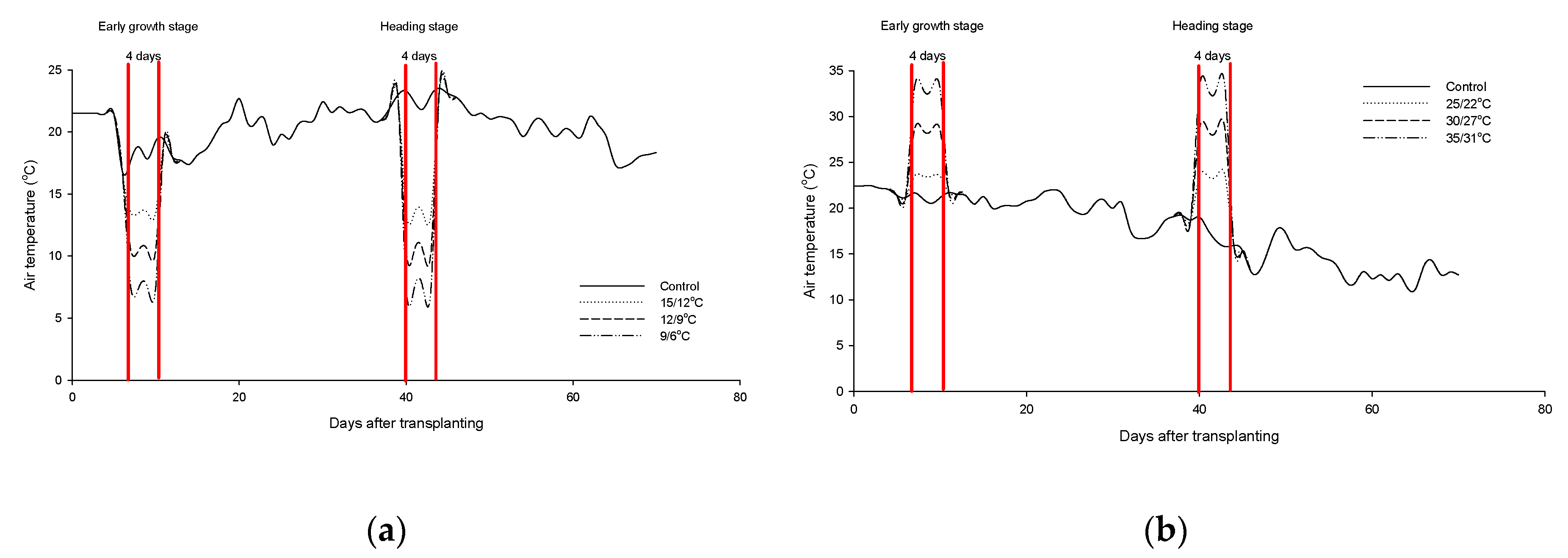
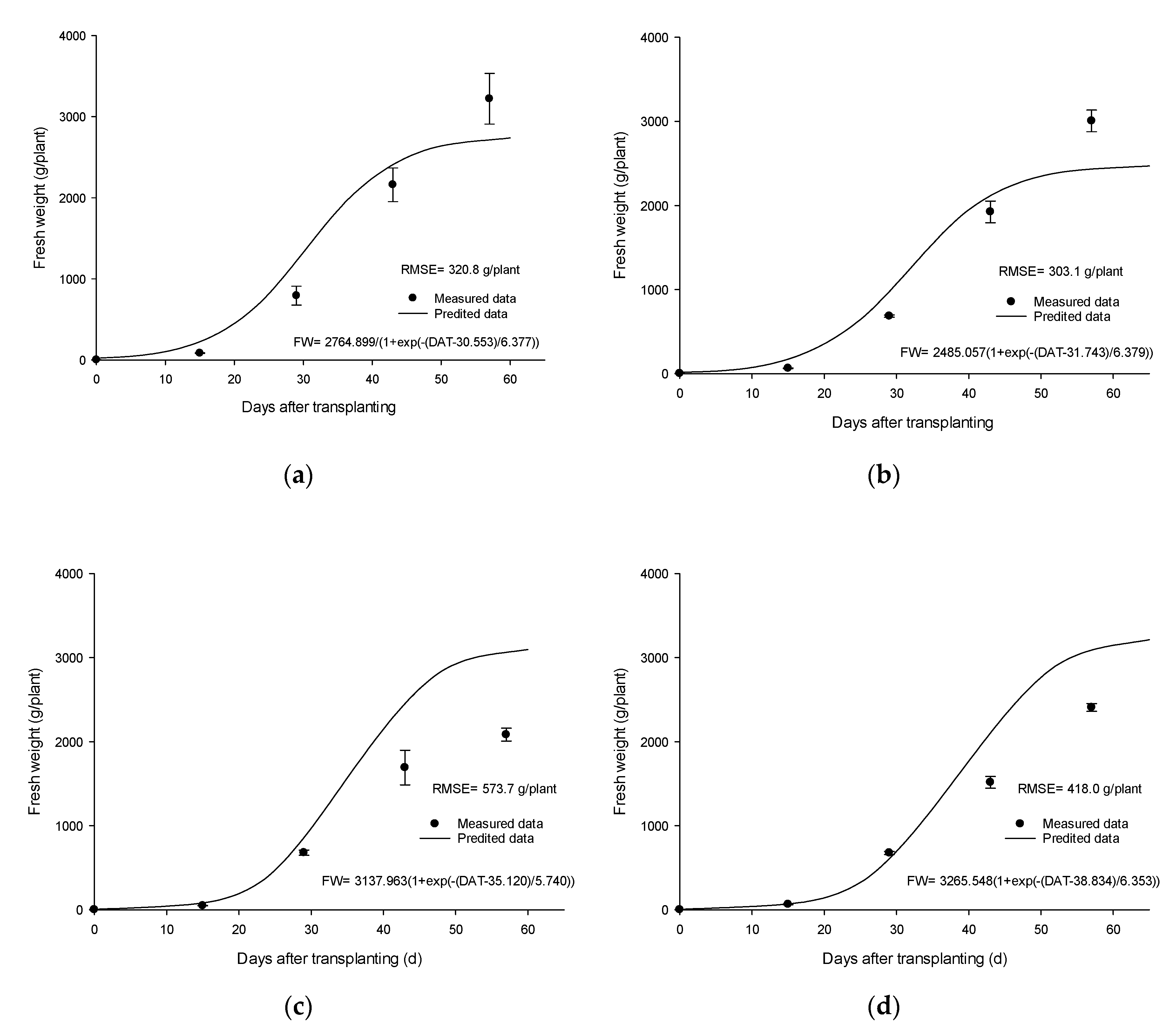
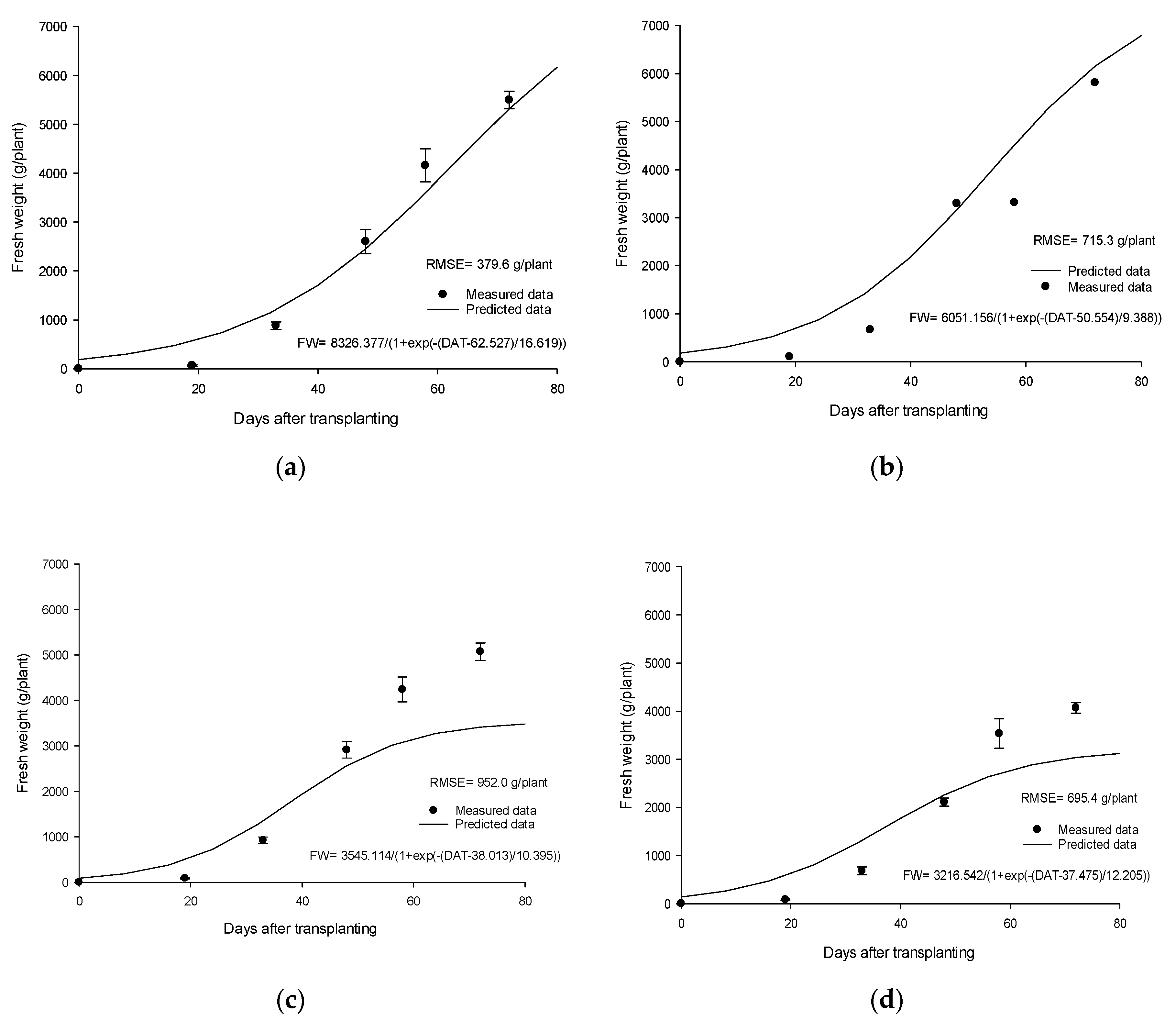
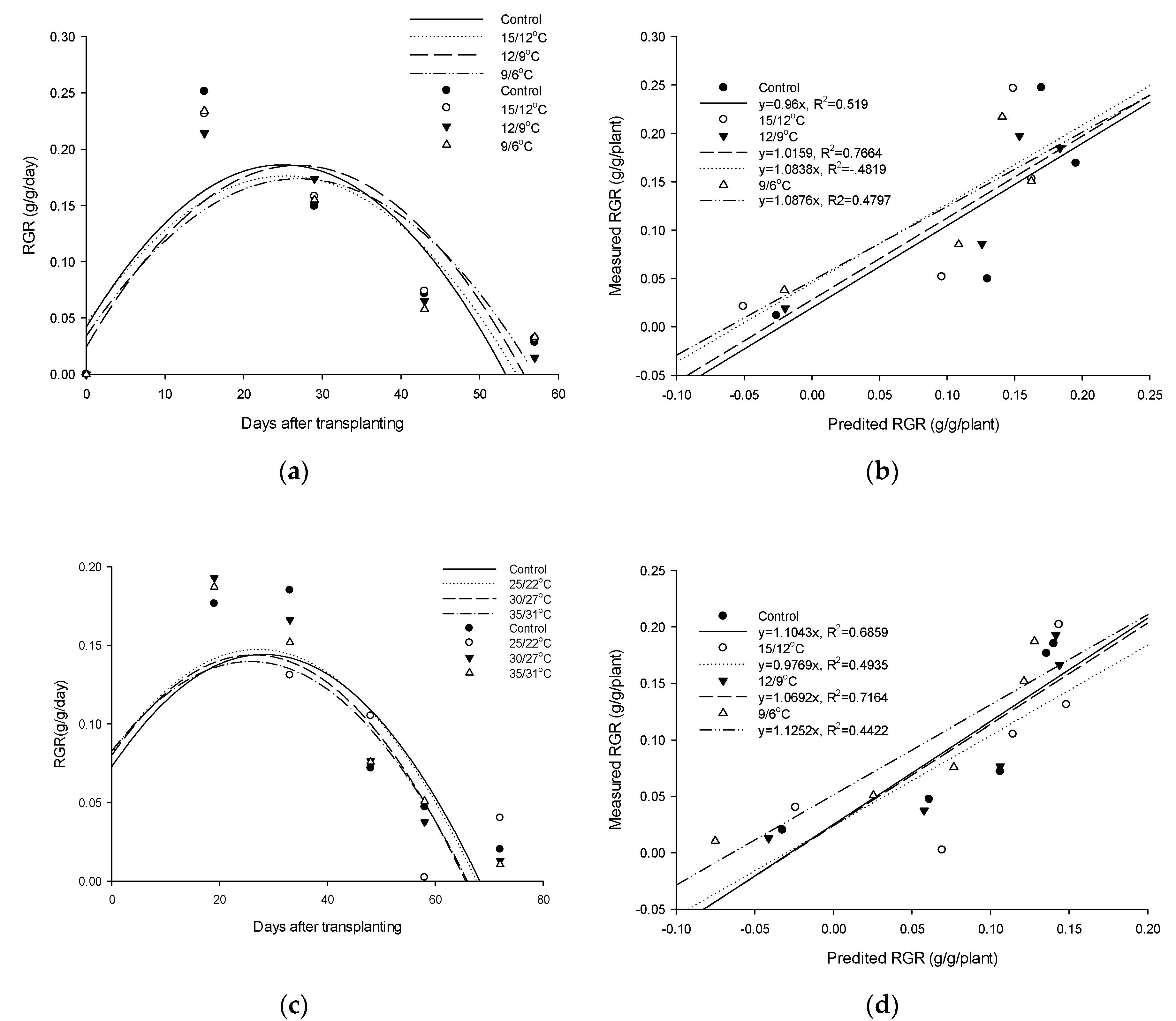
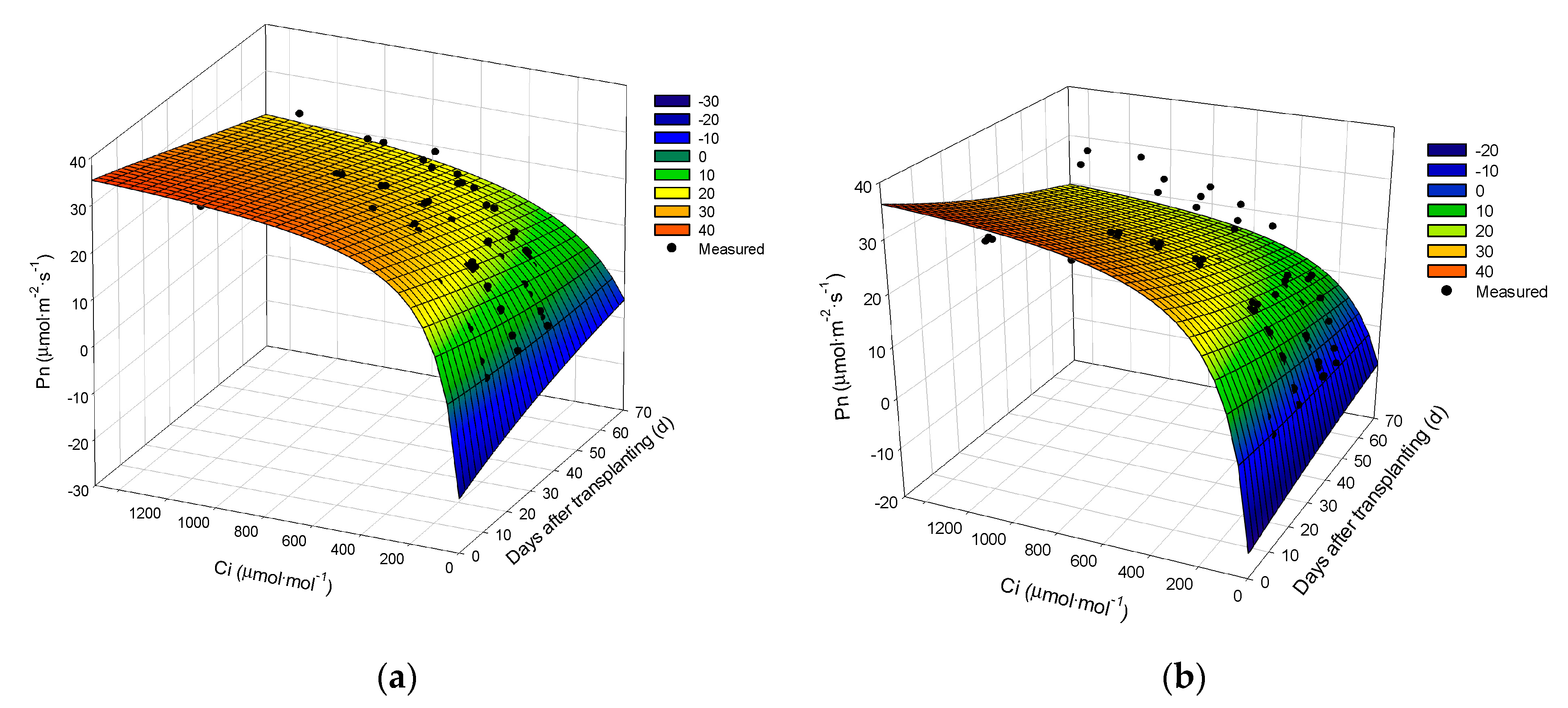
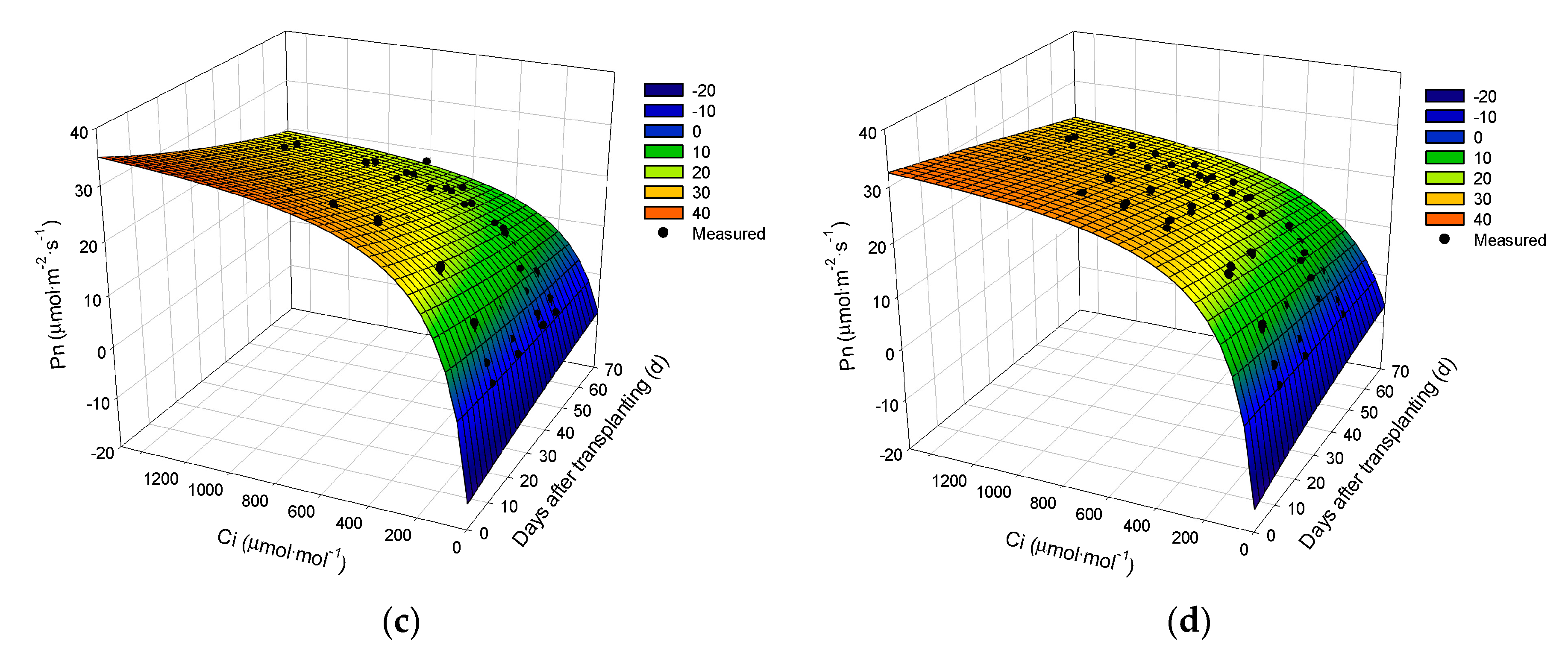
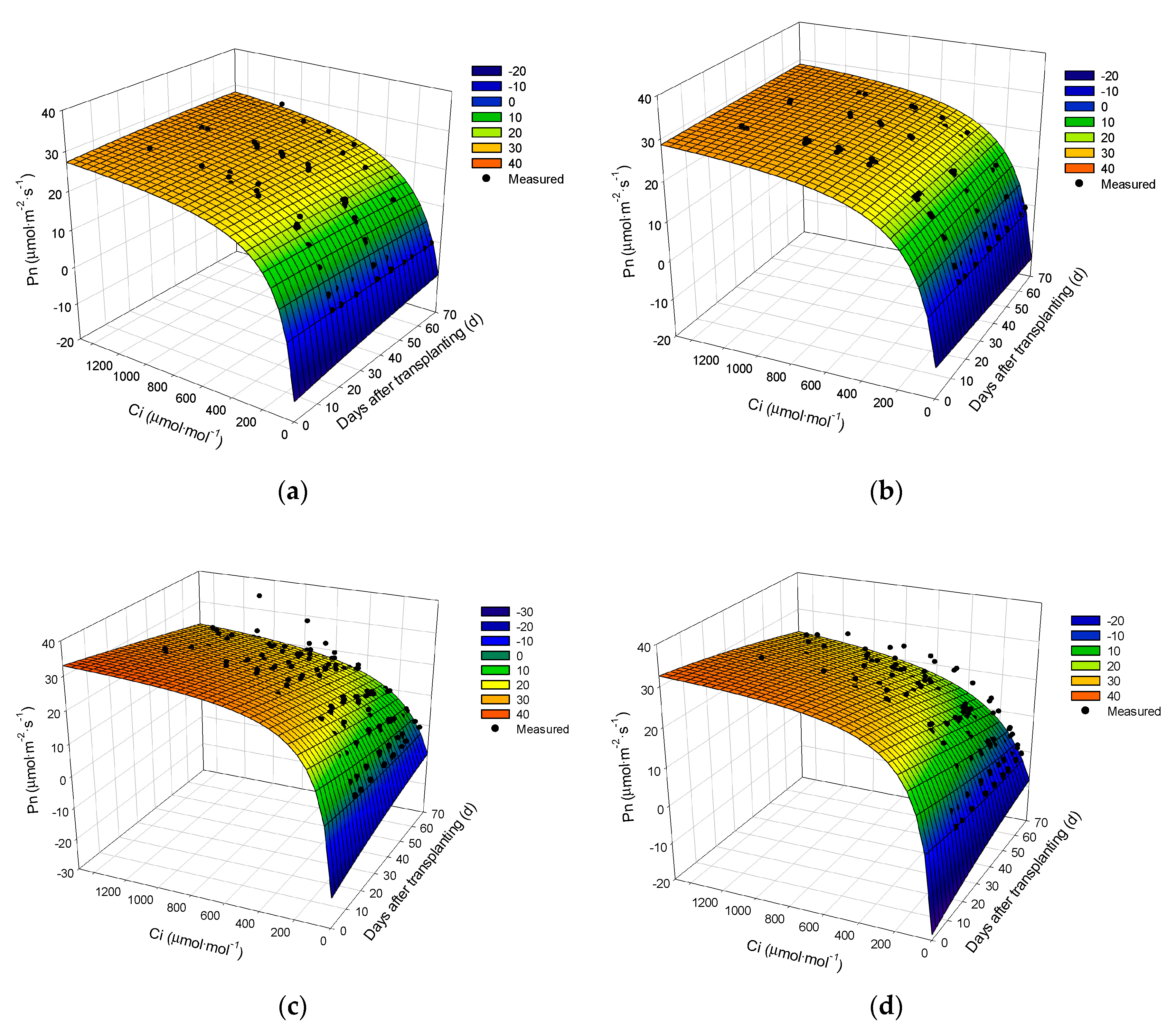
| Treatment | Fresh Weight (g/Plant) | Dry Weight (g/Plant) | Leaf Length (cm/Plant) | Leaf Width (cm/Plant) | Number of Leaves (/Plant) | Leaf Area (cm2/Plant) | ||||||
|---|---|---|---|---|---|---|---|---|---|---|---|---|
| 4 DAT 1 | ||||||||||||
| Control | 108.2 | a 2 | 8.2 | a | 25.4 | a | 16.6 | a | 17.0 | a | 1812.5 | a |
| 15 °C/12 °C | 107.3 | a | 8.6 | a | 24.7 | a | 16.4 | a | 16.7 | ab | 1672.9 | a |
| 12 °C/9 °C | 71.1 | b | 4.3 | b | 20.7 | b | 13.1 | b | 14.3 | c | 1040.0 | b |
| 9 °C/6 °C | 54.0 | b | 5.2 | b | 21.9 | ab | 13.9 | b | 15.3 | bc | 1219.8 | b |
| 18 DAT | ||||||||||||
| Control | 1157.8 | a | 67.9 | a | 39.2 | a | 33.7 | a | 59.0 | a | 11,248.0 | a |
| 15 °C/12 °C | 915.3 | b | 52.2 | b | 38.1 | ab | 32.8 | a | 49.3 | a | 8597.9 | b |
| 12 °C/9 °C | 717.2 | c | 40.6 | c | 34.1 | c | 27.3 | b | 46.0 | a | 6936.8 | c |
| 9 °C/6 °C | 586.8 | c | 30.8 | d | 35.0 | bc | 27.0 | b | 53.3 | a | 6248.9 | c |
| Treatment | Fresh Weight (g/Plant) | Dry Weight (g/Plant) | Leaf Length (cm/Plant) | Leaf Width (cm/Plant) | Number of Leaves (/Plant) | Leaf Area (cm2/Plant) | ||||||
|---|---|---|---|---|---|---|---|---|---|---|---|---|
| 4 DAT 1 | ||||||||||||
| Control | 93.9 | b 2 | 5.9 | b | 24.7 | b | 15.7 | b | 17.7 | b | 1929.4 | b |
| 25 °C/22 °C | 147.9 | a | 8.9 | a | 28.9 | a | 18.8 | a | 20.7 | ab | 2722.2 | a |
| 30 °C/27 °C | 139.3 | a | 8.9 | a | 28.6 | a | 20.5 | a | 22.0 | a | 2716.6 | a |
| 35 °C/31 °C | 128.4 | a | 8.4 | a | 27.9 | a | 16.8 | b | 22.3 | a | 2352.6 | ab |
| 18 DAT | ||||||||||||
| Control | 1061.0 | a | 48.3 | b | 47.8 | a | 33.6 | a | 48.0 | a | 12,923.0 | a |
| 25 °C/22 °C | 1209.8 | a | 60.2 | ab | 43.8 | b | 30.5 | ab | 46.7 | a | 13,500.0 | a |
| 30 °C/27 °C | 1147.8 | a | 57.0 | ab | 48.9 | a | 30.3 | ab | 45.0 | ab | 13,155.0 | a |
| 35 °C/31 °C | 1282.0 | a | 71.5 | a | 42.2 | b | 29.2 | b | 41.7 | b | 14,783.0 | a |
| Days After Transplanting | Treatment (°C, Light/Dark) | Photochemical Efficiency (μmol CO2/mmol) | Carboxylation Conductance (/s) | Dark Respiration (μmol CO2/m2/s) | R2 |
|---|---|---|---|---|---|
| 16 | Control | 0.096 | 0.388 | −13.347 | 0.994 |
| 29 | 0.094 | 0.305 | −13.572 | 0.994 | |
| 43 | 0.087 | 0.235 | −9.843 | 0.992 | |
| 59 | 0.063 | 0.079 | −5.789 | 0.991 | |
| 16 | 9/6 | 0.093 | 0.283 | −11.519 | 0.995 |
| 29 | 0.096 | 0.345 | −13.729 | 0.994 | |
| 43 | 0.068 | 0.184 | −6.903 | 0.994 | |
| 59 | 0.077 | 0.115 | −7.118 | 0.991 | |
| 16 | 12/9 | 0.093 | 0.279 | −11.388 | 0.996 |
| 29 | 0.098 | 0.360 | −15.639 | 0.992 | |
| 43 | 0.068 | 0.219 | −8.327 | 0.993 | |
| 59 | 0.072 | 0.133 | −8.872 | 0.995 | |
| 16 | 15/12 | 0.093 | 0.313 | −11.093 | 0.991 |
| 29 | 0.098 | 0.360 | −15.639 | 0.992 | |
| 43 | 0.081 | 0.257 | −9.371 | 0.991 | |
| 59 | 0.066 | 0.120 | −7.986 | 0.991 |
| Days After Transplanting | Treatment (°C, Light/Dark) | Photochemical Efficiency (μmol CO2/mmol) | Carboxylation Conductance (/s) | Dark Respiration (μmol CO2/m2/s) | R2 |
|---|---|---|---|---|---|
| 16 | Control | 0.085 | 0.315 | −11.462 | 0.993 |
| 29 | 0.092 | 0.410 | −15.873 | 0.992 | |
| 43 | 0.087 | 0.266 | −9.74 | 0.991 | |
| 59 | 0.074 | 0.162 | −6.786 | 1.000 | |
| 70 | 0.086 | 0.248 | −10.883 | 0.996 | |
| 16 | 25/22 | 0.090 | 0.311 | −12.152 | 0.991 |
| 29 | 0.094 | 0.369 | −15.298 | 0.987 | |
| 43 | 0.091 | 0.311 | −11.878 | 0.987 | |
| 59 | 0.095 | 0.349 | −15.459 | 0.992 | |
| 70 | 1.042 | 0.398 | −10.112 | 0.996 | |
| 16 | 30/27 | 0.096 | 0.442 | −15.281 | 0.990 |
| 29 | 0.104 | 0.437 | −17.612 | 0.992 | |
| 43 | 0.093 | 0.29 | −12.103 | 0.986 | |
| 59 | 0.082 | 0.219 | −13.036 | 0.991 | |
| 70 | 0.07 | 0.070 | −5.951 | 0.995 | |
| 16 | 35/31 | 0.099 | 0.422 | −14.659 | 0.993 |
| 29 | 0.094 | 0.357 | −14.793 | 0.992 | |
| 43 | 0.090 | 0.220 | −10.386 | 0.989 | |
| 59 | 0.081 | 0.136 | −8.947 | 0.968 | |
| 70 | 0.075 | 0.124 | −7.94 | 0.994 |
Publisher’s Note: MDPI stays neutral with regard to jurisdictional claims in published maps and institutional affiliations. |
© 2020 by the authors. Licensee MDPI, Basel, Switzerland. This article is an open access article distributed under the terms and conditions of the Creative Commons Attribution (CC BY) license (http://creativecommons.org/licenses/by/4.0/).
Share and Cite
Wi, S.H.; Lee, H.J.; An, S.; Kim, S.K. Evaluating Growth and Photosynthesis of Kimchi Cabbage According to Extreme Weather Conditions. Agronomy 2020, 10, 1846. https://doi.org/10.3390/agronomy10121846
Wi SH, Lee HJ, An S, Kim SK. Evaluating Growth and Photosynthesis of Kimchi Cabbage According to Extreme Weather Conditions. Agronomy. 2020; 10(12):1846. https://doi.org/10.3390/agronomy10121846
Chicago/Turabian StyleWi, Seung Hwan, Hee Ju Lee, Sewoong An, and Sung Kyeom Kim. 2020. "Evaluating Growth and Photosynthesis of Kimchi Cabbage According to Extreme Weather Conditions" Agronomy 10, no. 12: 1846. https://doi.org/10.3390/agronomy10121846
APA StyleWi, S. H., Lee, H. J., An, S., & Kim, S. K. (2020). Evaluating Growth and Photosynthesis of Kimchi Cabbage According to Extreme Weather Conditions. Agronomy, 10(12), 1846. https://doi.org/10.3390/agronomy10121846







